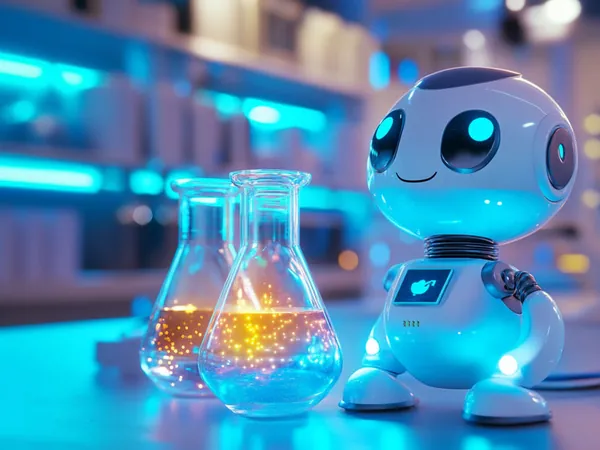
Robotics and AI: A Game-Changer for Science Laboratories!
2024-10-28
Author: Li
The world of scientific discovery is on the brink of a monumental transformation thanks to the integration of robotics and artificial intelligence (AI). According to Dr. Ron Alterovitz, a leading researcher and Lawrence Grossberg Distinguished Professor at the Department of Computer Science, the process of developing new molecules, materials, and chemical systems has traditionally been an arduous task that depends heavily on human labor. Scientists are often bogged down by the time-consuming trial-and-error method, where experiments must be meticulously designed, materials synthesized, and results analyzed repeatedly before yielding the desired outcomes.
But what if we could automate much of this process? The answer lies in robotics, which can carry out experiments tirelessly and continuously, thereby significantly accelerating research progress. These advanced robotic systems excel at executing precise experimental tasks with a level of consistency far surpassing that of their human counterparts. Importantly, they also mitigate safety risks by safely handling hazardous materials. This push towards automation allows researchers to redirect their focus toward complex research questions, ushering in new breakthroughs in fields like medicine, energy, and sustainability.
Dr. James Cahoon, Chair of the Department of Chemistry and co-author of the related research, believes that robotics can transform conventional labs into automated "factories" of discovery. However, for this paradigm shift to occur, innovative strategies are essential for ensuring seamless collaboration between humans and robots in laboratory settings. Predictions suggest continued advancements in automation will enhance the speed, accuracy, and reproducibility of experiments across various scientific disciplines. The data generated by these advanced robotics can, in turn, fuel AI systems, further refining future experiments.
Levels of Laboratory Automation
To help track the evolution of laboratory automation, researchers have proposed five distinct levels: 1. **Assistive Automation (A1)**: Basic tasks like liquid handling are automated, while humans manage most of the workload. 2. **Partial Automation (A2)**: Robots handle several sequential steps, with human monitoring during setup and oversight. 3. **Conditional Automation (A3)**: Robots conduct entire experiments, but human input is necessary during unexpected events. 4. **High Automation (A4)**: Robots operate autonomously, managing setups and responding to unusual conditions without human assistance. 5. **Full Automation (A5)**: This ultimate stage features robots and AI functioning completely independently, incorporating self-maintenance and safety protocols.
While lower levels of automation are increasingly common in labs today, achieving high and full autonomy remains a significant challenge. For robots to function effectively across varied lab settings, they need to manage intricate tasks and interact fluidly with both humans and other automated systems.
Furthermore, the role of AI transcends mere physical automation. AI's ability to analyze extensive datasets generated from experiments can unveil patterns and recommend new compounds or research pathways. Consequently, the incorporation of AI within laboratory processes promises to streamline the entire research cycle—from experimental design and material synthesis to data analysis.
In fully automated, AI-powered labs, the conventional Design-Make-Test-Analyze (DMTA) cycle could operate autonomously. AI could be tasked with determining which experiments to pursue, making real-time adjustments, and perpetually refining research methodologies. Although AI systems have made notable strides in areas like predicting chemical reactions and optimizing synthesis paths, experts underscore the necessity for careful oversight to prevent potential hazards—like the inadvertent creation of dangerous substances.
Transitioning to automated laboratories isn't without its hurdles, however. Laboratories vary widely in design and capability—from single-process setups to expansive multi-room facilities. Developing adaptable automation systems that operate seamlessly in these diverse contexts will require mobile robots that can transport materials and perform tasks across different stations.
Equally crucial is the need for training scientists to proficiently navigate these intricate automation systems. Future researchers will need to combine their scientific expertise with a solid understanding of robotics, data science, and AI. Fostering collaboration among engineers, computer scientists, and researchers will be vital in unlocking the full benefits of automated laboratories.
Angelos Angelopoulos, a co-author of the study and research assistant in Dr. Alterovitz's Computational Robotics Group, encapsulates the excitement surrounding this technological integration: "The integration of robotics and AI is poised to revolutionize science labs. By automating routine tasks and speeding up experimentation, we are entering an era where breakthroughs can occur more swiftly, safely, and reliably than ever before."
The convergence of robotics and AI thus stands not only to enhance scientific research but to redefine the very landscape of discovery itself. Are we ready for this transformative journey? The future of science is now—don't miss out!



 Brasil (PT)
Brasil (PT)
 Canada (EN)
Canada (EN)
 Chile (ES)
Chile (ES)
 España (ES)
España (ES)
 France (FR)
France (FR)
 Hong Kong (EN)
Hong Kong (EN)
 Italia (IT)
Italia (IT)
 日本 (JA)
日本 (JA)
 Magyarország (HU)
Magyarország (HU)
 Norge (NO)
Norge (NO)
 Polska (PL)
Polska (PL)
 Schweiz (DE)
Schweiz (DE)
 Singapore (EN)
Singapore (EN)
 Sverige (SV)
Sverige (SV)
 Suomi (FI)
Suomi (FI)
 Türkiye (TR)
Türkiye (TR)